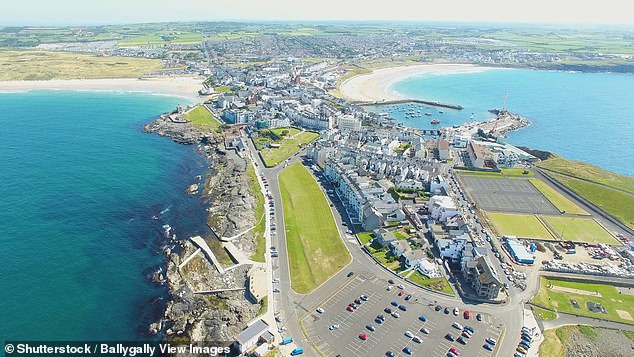From Ramore Head, a rocky promontory in the small seaside town of Portrush in County Antrim, you can see three countries on a clear day.
To the west, rise the hills of Donegal in the Republic of Ireland; to the north east lie Islay and Jura in Scotland (where George Orwell wrote Nineteen Eighty-four), and you are, of course, standing in Northern Ireland.
A particularly pleasant part of it. With its rugged cliffs, towering dunes and sweeping beaches, this must be one of Britain’s finest coastlines. And Portrush, population 6,150 (most of whom seem to know one another), makes the perfect base.
It is both convivial – as you find at the many little hostelries – and a curiously laid-out town. At the centre is the parrot’s beak-shaped harbour, above which Ramore Head spikes into the Atlantic Ocean like a tuft of feathers, while on each side run two beaches, West and East Strands.
These form the town’s ‘neck’ and ‘shoulders’, skirted by a promenade that discontinues beyond East Strand at the jagged dunes of the Royal Portrush Golf Club. This venue last hosted The Open in 2019, when Irishman Shane Lowry won, and will do so again next year.

Tom Chesshyre visits the seaside town of Portrush in County Antrim, Northern Ireland. He remarks that from the town’s Ramore Head promontory (above), it’s possible to see three countries

Quaint: Portrush harbour (above) sits at the town’s centre, reveals Tom
Portrush has a fine golf pedigree being the hometown of Graeme McDowell (a US Open champion), and where Darren Clarke, the Northern Irish former Open victor, set up home.
Golf lovers should visit the Harbour Bar, where Darren’s Corner (his favourite spot) and the front room are plastered with golfing paraphernalia.
A great way to arrive is by railway from Belfast, across rolling countryside (about two hours).
This brings you to a modern station adjoining a marvellous mock-Tudor stationhouse now home to another pub, The Station.

Pictured here is the old mock Tudor railway station, which is now home to a pub, ‘The Station’

Travellers to Portrush can follow the coast to the medieval remains of Dunluce Castle (pictured)

The Wishing Arch of White Rocks Beach is one of Portrush’s ‘nearby highlights’

Above is the mesmerising coastline at White Rocks Beach
Trains came to Portrush in 1855, bringing a southern tourist influx, though holidaymakers had already discovered the coast’s charms, thanks to steamers from Scotland and Liverpool.
Nearby highlights include the medieval remains of Dunluce Castle, the Wishing Arch of White Rocks Beach and the striking basalt columns of Giant’s Causeway. Then there’s Bushmills village, where the whiskey is distilled.
But Portrush, with its quaint harbour, jolly inns, little restaurants, and art deco Playhouse cinema/comedy venue, has plenty going for it. And some pretty good views, too.

